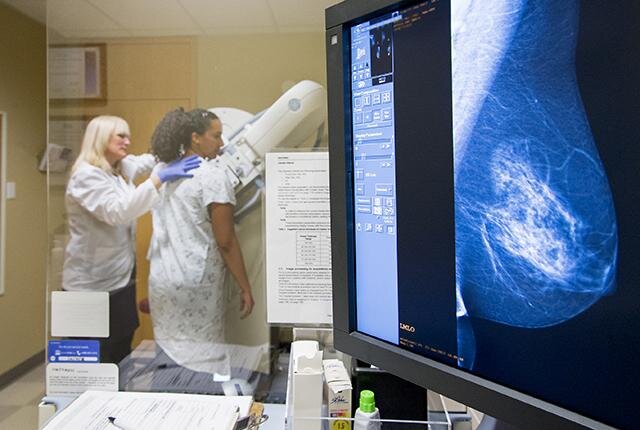Women of minority races and ethnicities and with less education and income have had relatively lower access to 3-D mammography, a technology that can improve breast cancer detection and decrease false alarms, according to research published today.
“This study was about whether adoption of this technology is equitable. We’re showing that it has not been, even though it has been FDA-approved for a decade now,” said Dr. Christoph Lee, professor of radiology at the University of Washington School of Medicine. “Black and Hispanic women, and less-educated and lower-income women have not been able to obtain 3-D mammography as easily as white, well-educated, and higher-income women.”
Lee was lead author of the paper, published in JAMA Network Open.
The research team reviewed 2.3 million breast-screening exams collected by the national Breast Cancer Surveillance Consortium, making it the largest-ever study of U.S. access to digital breast tomosynthesis (DBT), commonly called 3-D mammography. In February 2011, the Food and Drug Administration approved DBT as an alternative to digital mammography, then the standard of care. Subsequent observational studies have shown that DBT is more accurate than digital mammography by detecting more cancers and yielding fewer false-positive readings.
This study included patients’ screening exams from 92 imaging facilities across five states, and spanned January 2011 through December 2017. The researchers analyzed whether the facilities offered DBT onsite at the time of a screening exam, and compared the use of DBT and digital mammography across patient populations at those facilities.
“Given the large research sample and our longitudinal data collection, we were able to evaluate use by minority and traditionally underserved populations,” said Diana Miglioretti, Ph.D., professor and division chief of biostatistics at the University of California Davis and senior author on the study. “Unfortunately we were not surprised to find that these traditionally underserved populations were less likely to attend facilities that offered 3-D mammography, and even when they did, they were less likely to receive a 3-D mammogram.”
In 2011, only 3% of women in the study could access DBT at the time of their screening; by 2017, that figure had grown to 82%. Despite facilities’ adoption of 3-D technology over those seven years, the improved availability was not experienced equally.
When both 2-D and 3-D mammograms were available onsite at time of screening, DBT was obtained by:
37% of Black women vs. 43% of Asian-American women, 44% of Hispanic women, and 53% of white women41% of women with less than a high school education vs. 50% of women with a college degree44% of women living in zip codes with the lowest quartile of median household income vs. 51% of women living in zip codes with the highest quartile of median household income
“These subpopulations of women with poorer access to 3-D are already traditionally underserved and more at risk for greater morbidity and mortality from breast cancer,” Lee said.
The study did not address whether structural racism in healthcare environments or out-of-pocket costs might contribute to the lower access and use of new technologies among women of minority race/ethnicity. However, these may be real barriers, the researchers said.
“DBT costs more than 2-D because it generates digital ‘slices’ of breast tissue, which take more time to acquire and to interpret,” Lee said. “In 2018, Washington state enacted a law requiring facilities not to charge more for 3-D screening images and interpretation. So, even if a patient’s insurance doesn’t cover 3-D, they can still get it for the same cost as 2-D screening, which is free. But most other states don’t have such a law and, depending on a patient’s insurance, they may be told that they will have to pay out-of-pocket for the difference.”
In assessing education’s potential effect, Lee said women with higher achievement might have more opportunity to explore healthcare options and to know about 3-D mammography’s benefits. They might seek facilities where 3-D mammography is available and perhaps even ask for it directly, he suggested.
According to the FDA, more than two-thirds of U.S. screening facilities now offer DBT on at least one of their mammography units, but fewer than half of all certified units are actually DBT-capable.
Perhaps surprisingly, facility location—urban vs. rural—was not found to be a major factor of 3-D mammography availability. Lee offered context.
“If there is a rural site that has one digital mammography machine, and they switch to DBT, automatically their entire patient population has DBT access—whereas large, urban facilities may have several mammography units but can only afford to replace one at a time (at a cost of about $750,000 per) to become 3-D-capable. More of those patients will still be directed to the 2-D technology.”
He expressed concern that subpopulations of women are not receiving 3-D mammography even when they have that option at their facility at the time of screening.
“We’re going in the wrong direction. You have a lot more women in certain subpopulations benefiting from new technologies and other subpopulations not. Existing disparities in breast cancer screening outcomes could widen unless these factors are addressed,” he said.
Health insurers that have so far taken “stalwart” positions toward covering 3-D mammography have an opportunity to make a meaningful difference to underserved women, he added.
Risk assessment and prevention of breast cancer
More information:
Christoph I. Lee et al. Comparative Access to and Use of Digital Breast Tomosynthesis Screening by Women’s Race/Ethnicity and Socioeconomic Status. JAMA Netw Open. 2021;4(2) DOI: 10.1001/jamanetworkopen.2020.37546
Provided by
University of Washington
Citation:
Race, income, education affect access to 3-D mammography (2021, February 19)
retrieved 21 February 2021
from https://medicalxpress.com/news/2021-02-income-affect-access-d-mammography.html
This document is subject to copyright. Apart from any fair dealing for the purpose of private study or research, no
part may be reproduced without the written permission. The content is provided for information purposes only.



